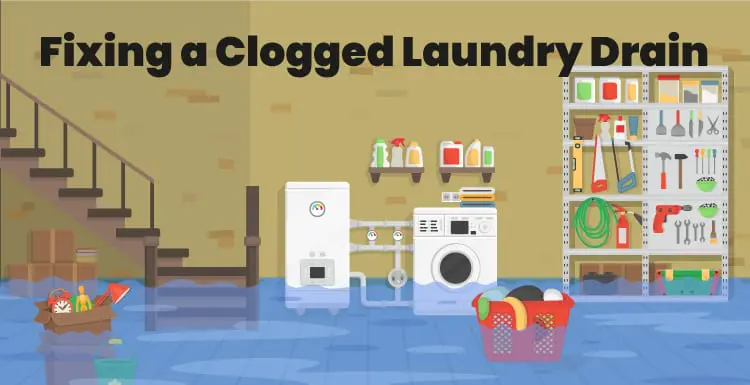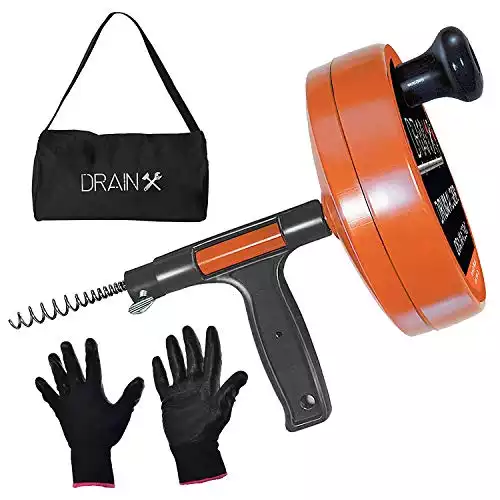Standing or slow-draining water on your laundry room floor or in your washing machine requires your immediate attention. A clogged laundry drain is likely causing the drain connected to your washing machine to overflow.
A clog in the washing machine drain will either spill water onto the laundry room floor as the washing machine drains or spill dirty water back into the machine as it cycles through.
A clogged laundry drain could be caused by anything from excess lint in the drain to a buildup of slimy, bacterial sludge. If you’re not ready to call in a plumber and want to try to fix a clogged laundry drain on your own, there are a few ways to do it.
We’ll show you the easiest methods to unclog a laundry drain yourself and when it’s best to call a plumber to do the job for you.
How to Fix a Clogged Laundry Drain
Before you take on the job of unclogging your laundry drain, it’s essential to understand the parts you’ll be working with and the tools you’ll need to take on the job.
The laundry drain carries the wastewater from washing clothes away from your washing machine via the rubber, flexible drainage hose. From there, the water travels through the drain into the sewer line.
There are several reasons why a laundry drain can clog:
- Foreign objects
- Laundry lint
- Animal hair
- Soap scum
- Grease and oils from clothes
- Corrosion
- Bacterial sludge
These blockages can slowly build up in the laundry drainpipe or suddenly become stuck. When that happens, wastewater that should travel down the drainpipe is unable to move through.
The drain backs up, spilling water onto the floor or back into the washing machine instead. To fix a clogged laundry drain, you’ll need to remove the blockage using special tools, a chemical drain cleaner, and hot water.
Diagnosing the Problem
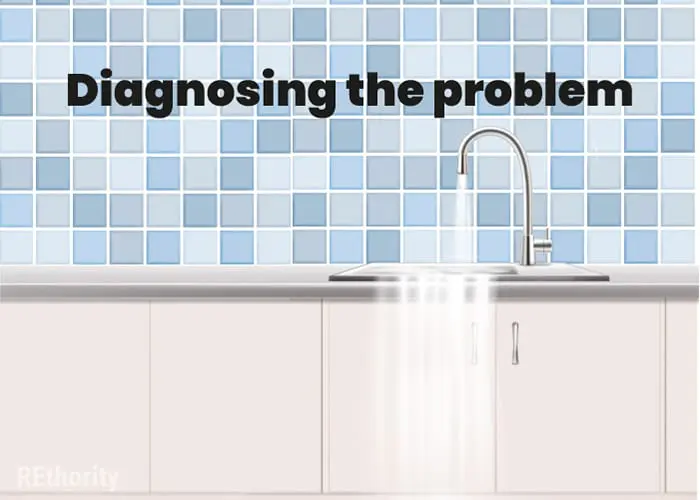
Before you start trying to unclog the drain, make sure the laundry drain really is the culprit. There are two simple ways to check.
1. Fill Your Sink
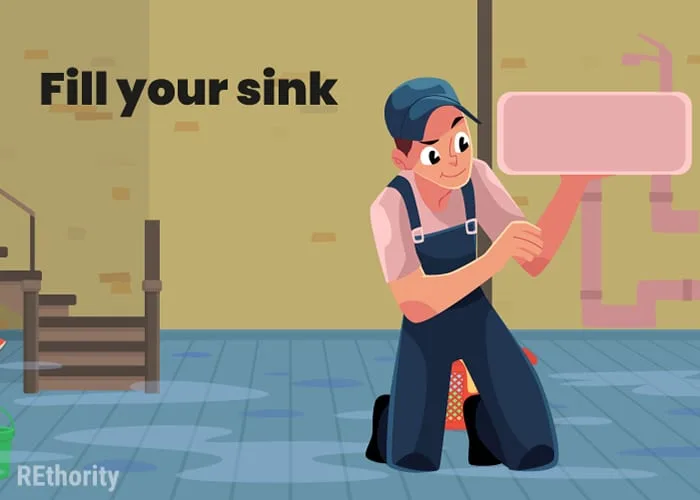
If you have a laundry room sink, fill it with water and then let it drain. If it drains quickly at first but then slows down or stops, it’s a good indicator that you’re dealing with a partial or full clog.
However, if the sink doesn’t drain at all, try using a plunger over the drain to remove the blockage; there’s a small chance it could solve your problem and help the water drain away.
2. Run the Washing Machine
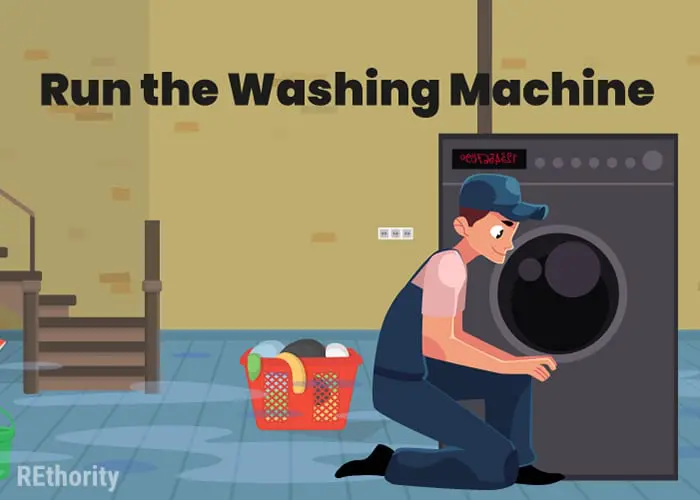
Fill your washing machine with water. Run it on the spin/drain cycle and watch the floor drain when the machine is draining.
If it spills over right away or very quickly, or if you suddenly see it overflowing where the discharge hose meets the wall, it’s a good indicator that the clog is nearby and easy to get to.
If it takes a while for the water to back up and spill over, the clog is likely further down the drain line. Let’s assume the blockage is within snaking or power auger distance (about 75 feet or less).
If this is the case, you can now attempt to clear it with either hot water, a chemical drain cleaner, a plumbing snake, or a more heavy-duty drain auger.
Unclog With Liquid
If the laundry drain isn’t severely clogged, you can start with the easiest method: just add water.
Unclog With Hot Water
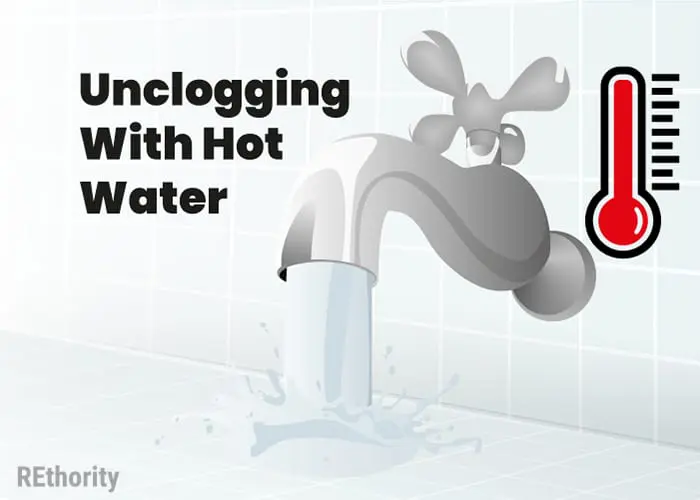
Unplug the washing machine and carefully move it out of the way without disturbing the hoses at the back. Then boil at least 1 gallon of water.
For an extra boost, you can add baking soda (about one cup) and a mixture of vinegar and water (use a 1:1 ratio). This can help power away any small or partial blockages in your drain.
Don’t mix the baking soda and vinegar into your boiling water. Add them separately after you’ve poured the water in. Remove the flexible rubber washing machine drain hose from the drainpipe.
This is usually located between the hoses where your machine connects with your water supply. You should be able to look down directly into the pipe.
Slowly pour the boiling water into the pipe. A funnel placed in the opening of the pipe and a pitcher with a narrow mouth may help you avoid spills. If you’re adding baking soda and vinegar, add the baking soda first.
Pour the vinegar/water mixture down after it. The boiling water, baking soda, and vinegar may dislodge and thin out any bacterial sludge or partial lint blockages that are clogging it.
But if hot water doesn’t do the trick, try using a drain cleaner. However, know that certain drain cleaners are abrasive, so don’t go overboard with them.
Using Drain Cleaner
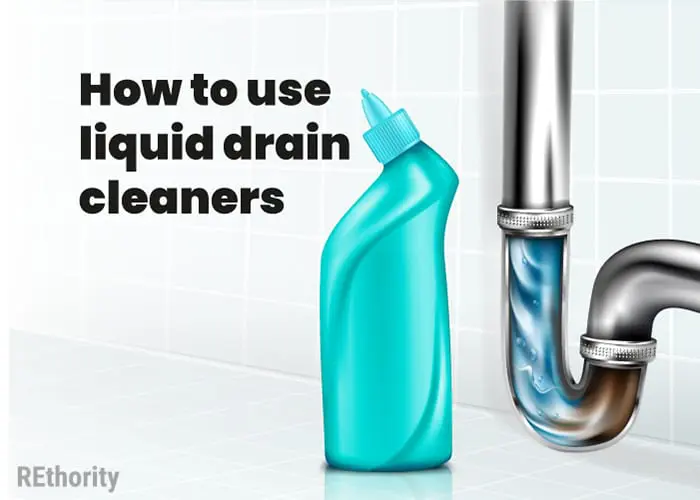
- Choose a non-corrosive chemical drain cleaner and thoroughly read the instructions. Use latex or protective gloves and eyewear.
- Unplug the washing machine and try to move it out of the way without disturbing the hoses at the back.
- Remove the flexible drainage hose from the drainpipe. Usually, it’s between the hoses where your machine connects to your water supply.
- Add the drain cleaner directly to the drain.
- After letting it sit for the recommended amount of time, follow with a rinse of hot water.
If these quick fixes don’t work, it’s time to turn to the tools plumbers use: drain snakes and augers.
Snake the Laundry Drain
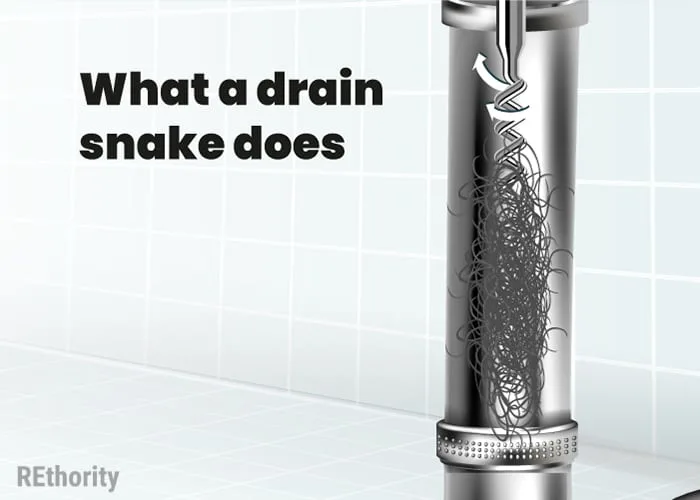
If your earlier test indicated that water backs up quickly when your washing machine is draining, the clog is probably not far down the drain line. For this kind of clog, a typical 25-foot drain snake should do the trick.
There are models that use a drill and models that are manual. The drill-powered snakes are more convenient to use. Look for a handheld plumbing snake at your local hardware store (expect to spend about $25).
How to Snake a Laundry Drain
- Gather some old towels, buckets, etc. to catch the excess water that will run out when you remove the drainage hose. Put on some latex gloves to protect your hands.
- Unplug the washing machine and move it enough to access the drain (usually located between the hot and cold water knobs). Lift the drainage hose out of the pipe and set it aside.
- Insert the spring end of the snake into the drain and feed it through until you feel some resistance or a sign of a blockage.
- Turn the handle or knob in a clockwise motion to make the snake’s wire head rotate and catch all pieces of the blockage.
- When it feels like the drain is clear, pull the snake out and remove the clogged debris from the head.
- Repeat the process if necessary to make sure you’ve completely removed the blockages.
- Put the drainage hose back into the drainpipe.
- Set your washing machine to the spin/drain cycle and check for any overflow or spilling.
If this didn’t fix your clogged laundry drain, your blockage may be further down the drainpipe than the snake could reach. Try the next method: Using a power auger.
Use a Power Auger
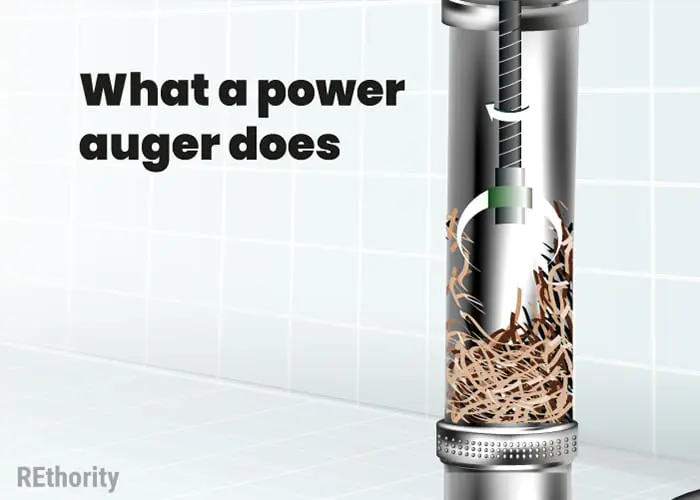
If it took a while for water to back up and spill over from your drain, the clog is probably further down the line in your plumbing system.
A 50-foot or 75-foot power auger, which uses heavy-duty wire cable to blast through blockages deep in the drain line, is your best tool.
Power augers start at around $250 but can be as much as $3,400. It’s much more cost-effective to rent one (expect to spend $50–$85/day) from a hardware store or equipment rental company.
When you’re ready to use the auger, follow the steps below.
How to Use a Power Auger
Have towels ready to catch any excess water that might come out as you remove the drainage hose. Put on latex gloves to protect your hands.
Unplug the washing machine and move it enough to access the drain (located between the hot and cold water knobs on the wall behind the washing machine).
Feed the Cable
Lift the drainage hose out of the pipe and set it aside. This is the laundry drainpipe. Plug in your power auger and start feeding the wire cable down into the drainpipe.
Your auger likely has foot pedal controls, allowing you to use your hands to guide the cable manually. Once you’ve fed a few feet of cable into the pipe, step off the pedal, set the auger to rotate clockwise, and step on the pedal to power it.
As it’s turning, continue guiding it down through the pipe. The rotation ensures it will touch every area inside the pipe and grab any clog or blockage in its way.
Cycle the Power
You’ll know you’ve hit a blockage when the auger motor sounds like it’s struggling or bogged down. Step off the pedal to change the rotation to counter-clockwise, then power it back on and continue feeding the cable through until you don’t feel any more resistance.
By letting the auger contact the debris in the pipe from different angles and continuing to feed it into the pipe, you will be able to bust through most blockages.
Pull the auger cable out of the drainpipe and remove the debris from the end. Pour plenty of hot water down the drain to flush any remaining bits of the blockage away.
Remove the Blockage
If it feels like there might have been more blockages in the pipe, or if you didn’t come close to using the full length of the cable, you may want to repeat the process. This will help you make sure you don’t leave a clogged area further down.
Replace the rubber drainage hose with the drain pipe. Plug in your washing machine and set it to the spin/drain cycle. If you successfully remove the drain clogs, it should drain without overflowing or spilling.
Call a Plumber
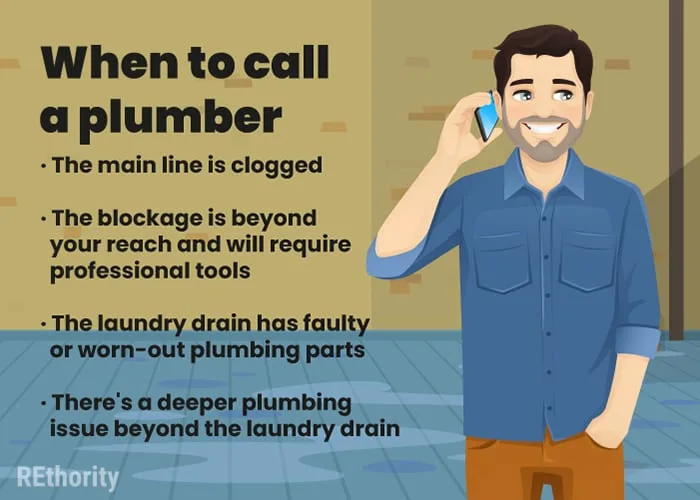
If you’ve tried hot water, chemical drain cleaners, a plumber’s snake, and a power auger with no success, it’s time to call a plumber. You could be dealing with a few issues:
- The main line is clogged
- The blockage is beyond your reach and will require professional tools
- The laundry drain has faulty or worn-out plumbing parts
- There’s a deeper plumbing issue beyond the laundry drain
We partnered with Networx to help you find local plumbers in your area. Click to below to get a FREE quote.
Any one of these scenarios is best left to a trained professional. For reference, you can expect to pay around $151 to $214 for a plumber or drain cleaning company to come out and fix a clogged laundry drain.
Whatever you do, don’t ignore the issue and wait to get it fixed. The longer a blockage or clog is in your drainpipe, the more stress it can put on your plumbing and the more damage it can cause in your home.

